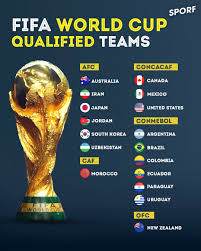The 2026 FIFA World Cup is already shaping up to be the biggest in the tournament’s history. With an expanded 48-team format and a historic three-nation hosting arrangement between the United States, Mexico, and Canada, this edition promises both scale and spectacle. As qualification enters its final stretch, national teams across every continent are battling for a spot in what is expected to be a record-breaking global event.
Countries That Have Already Qualified
By mid-October 2025, 28 nations have officially secured their places in the 2026 FIFA World Cup. These countries represent every footballing region and reflect a mix of traditional powerhouses and emerging teams making history.
Host Nations (Automatic Qualification):
United States, Canada, and Mexico automatically qualified as co-hosts. This marks the first time three nations will jointly host a World Cup, giving North America a central role in one of the most anticipated global sporting events.
Africa (CAF):
Algeria, Cape Verde, Egypt, Ghana, Morocco, Senegal, South Africa, Tunisia, and Ivory Coast have sealed their spots. Cape Verde’s qualification is particularly historic — it’s the nation’s first-ever appearance at a FIFA World Cup, marking a significant milestone for the small island country.
Asia (AFC):
Australia, Iran, Japan, Jordan, South Korea, and Uzbekistan have confirmed their participation. Uzbekistan’s qualification stands out as they join the elite list of Asian nations heading to the global stage for the first time.
Europe (UEFA):
So far, England has become the first European nation to officially qualify, with several others on the brink of doing so. Europe has the highest number of allocated slots — sixteen — and competition remains fierce across the continent.
South America (CONMEBOL):
Argentina, Brazil, Colombia, Ecuador, Paraguay, and Uruguay have all qualified. As usual, the South American zone has delivered intense competition, with football giants like Brazil and Argentina continuing their consistent World Cup presence.
Oceania (OFC):
New Zealand has taken the direct qualification spot for Oceania, maintaining its dominance in the region’s football landscape.
That leaves around 20 more teams yet to be confirmed through ongoing qualifiers and playoffs.

Teams Still Battling for Qualification
With the final stretch approaching, several nations across different continents are still in contention — either fighting through group stages or preparing for inter-confederation playoffs.
Africa (CAF)
Africa will be represented by nine direct qualifiers and one additional spot through the inter-confederation playoff. The race for that last slot remains fierce, with teams like Nigeria, Cameroon, Democratic Republic of the Congo (DRC), and Gabon expected to feature in the playoff round. These crucial matches are scheduled for November, and the winner will proceed to face teams from other confederations for a final ticket.
Asia (AFC)
Asia has eight direct qualification slots and one playoff position. The United Arab Emirates and Iraq are among the teams still in the running for the remaining playoff position. Their decisive two-legged clash is set to determine which Asian team will advance to the inter-confederation playoffs.
Europe (UEFA)
Europe’s qualification process is still ongoing, with fifteen out of sixteen slots yet to be filled. The group winners from across the continent will qualify automatically, while the remaining spots will be decided through playoffs scheduled for early 2026. Traditional football nations like France, Germany, Spain, and Portugal are all on course to qualify, but several mid-tier teams like Norway, Scotland, and Ukraine are also pushing hard for inclusion.
North and Central America (CONCACAF)
Since the three host nations — the United States, Mexico, and Canada — have already qualified automatically, the remaining teams in the region are battling for three direct qualification spots and two inter-confederation playoff slots. Countries like Costa Rica, Honduras, Jamaica, and Panama are still very much in the mix, with the final qualifying rounds set to wrap up early next year.
South America (CONMEBOL)
Six South American teams have already qualified, leaving one inter-confederation playoff spot open. Bolivia currently occupies that position but faces stiff competition from Chile and Peru as the qualifying rounds conclude.
Oceania (OFC)
New Zealand has secured the region’s guaranteed spot, while New Caledonia is expected to compete in the inter-confederation playoff as Oceania’s second representative. For smaller football nations in the Pacific, this presents a rare chance to appear on the world stage.
The Inter-Confederation Playoffs
The inter-confederation playoffs are one of the most dramatic phases of the World Cup qualification process. Scheduled for March 2026, they will determine the final two teams to complete the 48-team lineup.
Six teams — one each from Asia, Africa, South America, and Oceania, and two from North and Central America — will compete for those two remaining tickets. The highest-ranked teams among them will be seeded, meaning they’ll face off against the winners of the initial playoff matches to determine the final qualifiers.
This playoff stage is often where smaller nations get a chance to shock the world, as seen in previous editions. For countries like Nigeria, Iraq, or New Caledonia, this could be the defining moment that propels them onto football’s biggest stage.
The Host Nations: United States, Mexico, and Canada
The 2026 World Cup will be the first ever co-hosted by three countries. Each of the host nations brings a unique football culture and infrastructure to the table:
- The United States will host the majority of matches, including the final, which is set to take place at MetLife Stadium in New Jersey. The U.S. will also stage group and knockout matches in cities such as Los Angeles, Miami, Dallas, Boston, and Seattle.
- Mexico, a two-time World Cup host (1970 and 1986), will stage matches in Mexico City, Guadalajara, and Monterrey, blending football tradition with a festive national spirit.
- Canada will host games in Toronto and Vancouver, marking a major milestone for the country’s rapidly growing football community.
This tri-nation model will not only showcase the diversity of North America but also make the tournament more accessible to fans across the continent. It will be the first time the FIFA World Cup takes place across three countries and the first with 48 teams, meaning 104 matches will be played over a span of 39 days.
Tournament Timeline and Expectations
- Final Qualifiers and Playoffs: Conclude by March 2026.
- World Cup Draw: Scheduled for December 2025 in Washington D.C.
- Tournament Dates: The competition will run from June 11 to July 19, 2026.
With 16 groups of three teams each, the tournament format ensures that every match counts. The top two teams from each group will advance to the knockout stages, making for a packed schedule and more global representation than ever before.
As the countdown continues, the final qualification rounds and playoffs will shape the final lineup for the 2026 FIFA World Cup. For nations like Nigeria, Iraq, and Bolivia, these next few months represent the last chance to secure their ticket to the global stage. For fans, anticipation is already building — not just for the football itself but for the cultural and logistical spectacle of a tournament that spans an entire continent.
The 2026 edition is more than just a competition; it’s a celebration of global unity through sport, symbolising a new era for international football.


